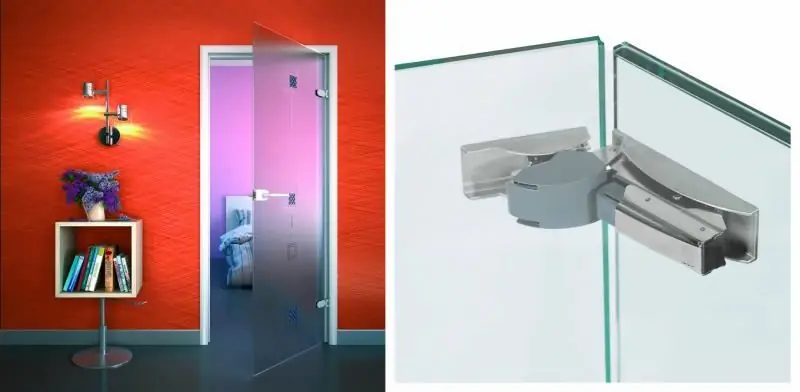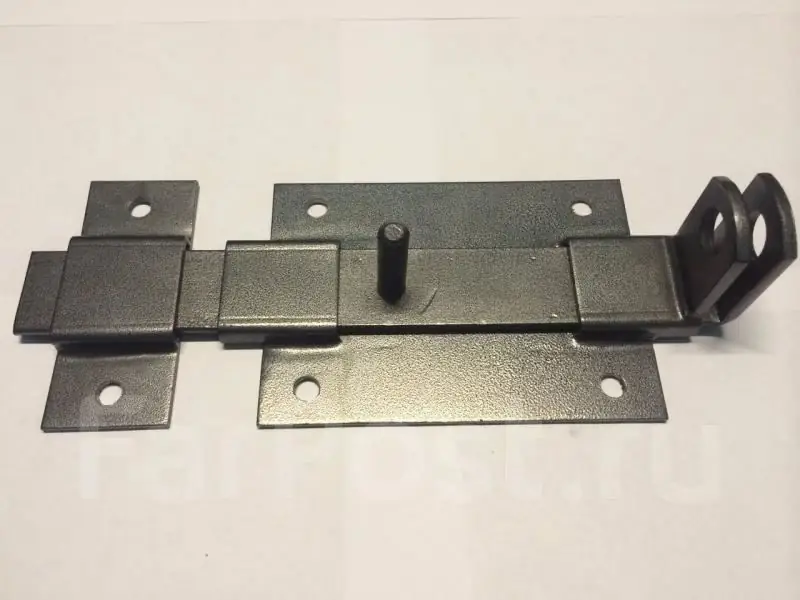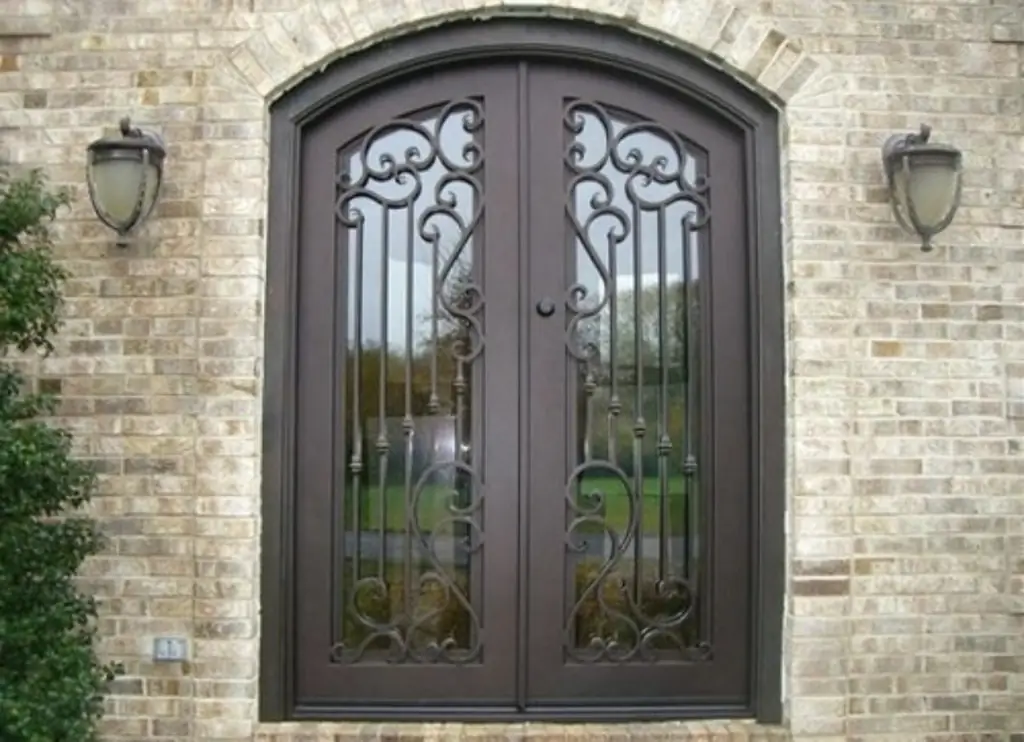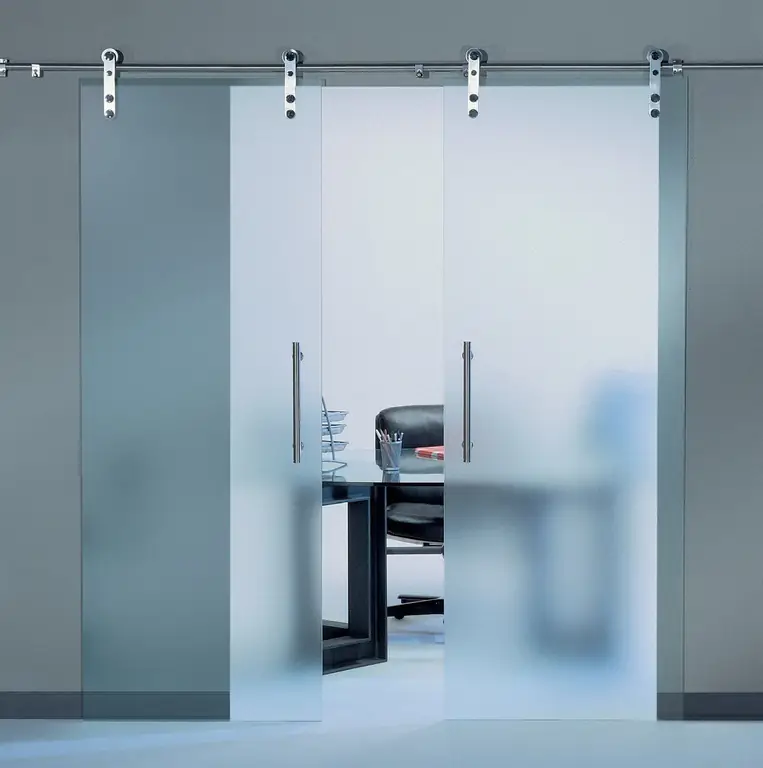
Table of contents:
- Author Bailey Albertson [email protected].
- Public 2023-12-17 12:53.
- Last modified 2025-06-01 07:32.
Types of hinges for glass doors, their features and installation

Although glass doors look light and weightless, remember that glass is a heavy material. And this is important to consider when choosing hinges for such structures. All fittings must be of high quality to ensure reliable fastening of the glass door and its trouble-free operation for many years.
Content
-
1 Types of hinges for glass doors
1.1 What material are hinges for glass doors made of?
-
2 Types of loops
-
2.1 Features of overhead loops
2.1.1 Video: self-assembly of the glass door in the cabinet
-
2.2 Glass door hinges with door closer
2.2.1 Video: installation of hinges with a door closer
- 2.3 Pendulum loops
- 2.4 Video: types of hinges for glass doors
-
-
3 Features of fastening hinges to a glass door
-
3.1 Installation with drilling
3.1.1 Video: Attaching the hinge to the drilled hole
- 3.2 Installation without drilling
-
- 4 Adjusting the hinges on the glass door
- 5 Reviews
Types of hinges for glass doors
Modern technologies make it possible to create strong glass, so such doors are popular and considered safe. For the installation of a glass door, you will need special hinges: strong, but at the same time graceful to decorate its appearance.

Glass doors can be installed in the steam room and shower, between rooms, mounted in furniture, and armored models - even at the entrance to the house
Glass door hinges differ from conventional awnings in the following characteristics:
- specific mounts - allow you to fix a thin glass sheet;
- high strength and reliability - since glass is heavy;
- beautiful appearance - they correspond to the style of the canvas, are elegant, with clear lines;
- high cost - more expensive than conventional loops, since only high-quality materials are used for their manufacture.
What material are hinges made of for glass doors?
To make such loops, use:
- zinc alloy;
- brass alloy;
- bronze;
- stainless steel;
- aluminum.
The cheapest and most affordable hinges are made of aluminum and zinc alloy. According to their characteristics, they are inferior to steel and brass. Bronze hinges are more expensive than others, but they also have a much longer service life. Some manufacturers give a lifetime warranty for high-quality bronze and brass hinges, so we can conclude about their strength. But there are options when different materials are used to make one element.

The execution of the hinges in different colors allows you to choose the right fittings for each specific case, based on the style and colors of the interior
When choosing hinges for a glass door, the design of the room and the permissible load on the fittings during operation are taken into account.
Types of loops
Glass door hinges are classified by:
-
installation type:
- mortise - holes are made in the glass for their installation;
- overhead - tightened with bolts without drilling;
-
purpose:
- for steam rooms and showers;
- for furniture doors;
- for interior doors;
-
type of construction:
- swing - open inward or outward;
- pendulum - open in both directions;
- sliding - move along special runners to the sides.
The hinges also differ in the mounting method:
-
to the door frame - suitable for swing doors;

Fastening glass doors to a door frame Fastening glass doors to a door frame is used in most cases and is considered the most common method.
-
to the floor and ceiling - placed on swing doors;

Fastening doors to floor and ceiling Fixing doors to the floor and ceiling is convenient for wide glass panes and double doors in rooms with large free space
-
to the wall - option for sliding doors (barn, etc.);

Fastening the glass sheet from above Fastening the glass sheet above the opening helps to gain space as the doors slide along the wall
-
to other glass - they are used for accordion doors or for shower stalls.

Fastening a glass door to another glass Fastening a glass door to another glass allows you to visually increase the space of a small room due to the transparency of such a design
When choosing hinges for a glass door, it is important to pay attention to the following characteristics:
- glass thickness - it can be from 4 to 12 mm;
- maximum web weight;
- the shape and method of fastening the loop - horizontal or vertical;
- opening angle - can be from 90 to 360 degrees;
- appearance - the hinges must match the design of the room;
- self-closing function - allows you to hold the canvas on the last centimeters. This prevents the door from hitting when closing;
- the presence of a built-in stopper - fixes the canvas in a closed state.
Features of overhead loops
To install such hinges, you do not need to drill glass. They are mounted on lightweight glass sheets, fasten quickly and have a streamlined shape. Overhead hinges are of two types:
-
Clamping - the glass is inserted into the hinge and fixed with bolts. To protect the glass, rubber, adhesive or plastic spacers are placed in this place. The choice of the type of these seals depends on the thickness of the glass:
- if the glass is 4-5 mm, glue pads are placed;
- if it is 5-8 mm - plastic;
-
with a thickness of 8-12 mm - rubber.

Glass door clamping hinges Clamping hinges are available in different shapes and sizes to match the exact fit to a specific glass door
-
Persistent - used for installing glass doors in sideboards and cabinets. The thickness of glass for a furniture sash is usually 4-6 mm. Shallow holes are made in the upper and lower parts of the cabinet opening. Bushings with hinges are inserted into them. Then glass is put into the loop, seals are laid on both sides of it. Then the sash is vertically aligned and fixed with screws. It is recommended to use stop hinges together with magnetic holders, so that the ends of the doors are firmly pressed against the cabinet.

Stop hinges for glass door leaves Thrust hinges are used only for fastening to furniture, where you need to connect a wooden opening with a glass door
Video: self-assembly of a glass door in a cabinet
Glass door hinges with door closer
This version of the hinges has a built-in closer (damper, shock absorber). But there are models in which the shock absorber can be overhead. The hinges with a door closer begin to smoothly close the door after its opening angle becomes less than 30-35 degrees.

Door closer hinges ensure smooth closing of the glass door
Some manufacturers use a conventional spring instead of gas or oil in the closer. Although the cost of such structures is low, they will not last long.
Video: installation of hinges with a closer
Pendulum hinges
Such pivot hinges allow doors to be opened in both directions, which is why they are also called carousel hinges. Usually, pendulum hinges are installed in the floor and in the ceiling, so that the door leaf can even rotate 360 degrees. In order to restrict the movement of the door during closing in the last centimeters, it is recommended to install door closers.

Mounting glass doors on pendulum hinges is considered not a very difficult and affordable process.
Video: types of hinges for glass doors
Features of fastening hinges to a glass door
Installation of glass doors in the opening has a number of features:
- heavy weight - therefore, it will not be possible to install it without an assistant;
- a certain size - such a canvas cannot be adjusted in place, therefore, its dimensions can be determined only after the final finishing of the doorway;
- relatively low strength - modern glass doors are made of tempered glass or triplex. But with careless installation and during careless operation, the canvas is still easy to damage;
- the presence of a door frame - it is necessary to determine in advance the door model: whether there will be a door frame or not.
To attach the hinges to glass doors, you need the following tools:
- electric drill with carbide drills;
- building level;
- door hinges;
- screwdriver;
- tape measure or long ruler;
- marker.
There are several ways to install hinges on a glass door:
- with drilling - holes are made in strictly defined places of the door leaf. After that, the two parts of the hinge are tightened with bolts.
- without drilling - the glass is inserted into the hinge and clamped firmly.
- with partial drilling - not through holes, but small recesses are made in a thick glass sheet. They are needed to center the clamping elements, and the rest of the hinge is simply pressed against the canvas.
- mounting on special glue is a disadvantage of this method: it will no longer be possible to remove the hinges.
Drilling installation
If the weight of the door exceeds 20 kilograms, then for more reliable fixation it is better to drill holes for the hinges in it. This solution has several advantages:
- clearly marked installation site;
- strong connection;
- even distribution of the weight of the web;
- there will be no movement of the loops.
However, installation with glass drilling has disadvantages:
-
you will need special tools (drills);

Drilling a hole of the desired size in glass with a choice of drill It is necessary to drill a hole in the glass at the minimum speed of the electric drill, choosing the appropriate type of drill
- work must be carried out with high precision;
- it will be impossible to replace one type of loops with another.
The installation process for through-fastening door hinges consists of the following steps:
-
Marking the surface of the canvas for the existing hinges.

Glass door hinge with through fastening The hinge with through fastening is applied to the glass door in the desired place, then the points of future holes are marked on the glass
-
Making holes:
- degreasing - the drilling site is wiped with a solvent or alcohol;
- creation of a bath - plasticine rollers in the form of a bath are laid around the place of the future hole. Turpentine is poured into it. But you can just drip turpentine onto the glass while drilling;
- drilling - at the minimum speed of the electric drill, holes of the required size are made with special carbide drills.
-
Fixation of hinges on glass sheet.

Fixing the loops on the canvas The canvas in such a loop is fixed through and through with bolts
- Installation of hinges to the frame or wall.
- Functionality check. After installing the glass door, its movement is adjusted.
Video: attaching the hinge to the drilled hole
You can also make a hole in the glass using sand and solder. The work is performed in the following sequence:
- Markup.
- Degreasing the surface.
- Preparation - a layer of wet sand 3 cm thick is poured onto the glass. In the place where there will be a hole, an even funnel of the required diameter is made in the sand with a stick.
-
Hole creation - solder (tin or lead) is heated and carefully poured into the funnel. After a few minutes, the solder solidifies, the sand and solder are removed from the glass. This creates a hole.

Hole in glass If there is no special drill for glass, then the hole can be made using heated solder
Installation without drilling
If the weight of the canvas is small, then you can use a simple and affordable method of mounting hinges without drilling. Sequence of work:
- Marking places for hinges.
- Installation of hinges - the door leaf is inserted into the groove and tightened with clamping bolts.
- Fastening a door with installed hinges to the opening.
To increase the strength of fixing such hinges, you can additionally use special glue or take hinges for blind holes
Glass door hinge adjustment
After installing glass doors, the hinges must be correctly adjusted. This process is carried out carefully and slowly so as not to damage the canvas. Let's consider the adjustment of the hinges using the example of a glass door of a shower stall, it is performed in several stages:
-
Vertical and horizontal adjustment. After fixing the glass door to a wall or a fixed screen, its verticality is checked using a building level. To correct the position of the canvas horizontally, there are oval holes in the counter strip attached to the wall. By moving the hinge relative to these holes, the position of the door is adjusted. After leveling the door, both hinges are finally secured with the center bolts.

Glass door fixing adjustment diagram The blade is adjusted using the oval holes on the hinge bar
-
Pressure adjustment. A check is carried out: how easily and smoothly the suspended door leaf moves. If the glass door does not fit tightly to the seals, then it is adjusted using special screws. They are usually located on the top of the hinge and are adjusted with a hex wrench. The necessary clamping of the door is achieved, after which decorative covers are put on the hinges.

Belt fit adjustment Using a hex key, the sash with fixed hinges is removed inside the glass shower
Reviews
Glass doors are popular because they allow you to create a unique design of the room. To fix them, you must choose and install the door hinges correctly. These fittings should not only be durable, but also have a beautiful appearance, because they are always in sight. Depending on the type of loops, their installation method will also differ, but you can cope with the installation of any structures with your own hands.
Recommended:
Door Latch (latch): Varieties With Description And Characteristics, Pros And Cons, As Well As How To Properly Install On The Door

The purpose of the door latch. Principle of operation. Types of door valves. Installation of various types of valves. Features of installation on different types of doors
Glass Entrance Doors: Varieties, Device, Components (including Glass), Installation And Operation Features

The device and types of entrance doors with glass. Repair and adjustment, troubleshooting. Fittings for doors with glass. Maintenance and care
Interior Doors Are Glass Or With Glass Inserts: Varieties, Device, Components, Installation And Operation Features

Arrangement of different types of doors made of glass and with glass inserts. Choice of accessories and door mounting technology. Breakdown and repair of interior doors
Door Latch: Varieties With A Description And Characteristics, Pros And Cons, As Well As How To Properly Install On The Door

Purpose of the door latch. Types of door latches, features of their device, advantages and disadvantages. The process of mounting and dismantling the door latch
Butterfly Door Hinges For Interior Doors: Description, Design Features, And How To Install Correctly

The device and purpose of loops without a tie. Pros and cons of using. Installation features, materials and tools required. Reviews
